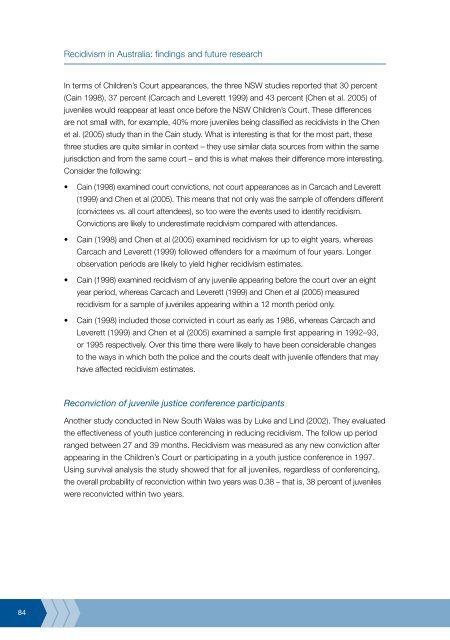Recidivism in Australia : findings and future research - Australian ...
Recidivism in Australia : findings and future research - Australian ...
Recidivism in Australia : findings and future research - Australian ...
Create successful ePaper yourself
Turn your PDF publications into a flip-book with our unique Google optimized e-Paper software.
84<br />
<strong>Recidivism</strong> <strong>in</strong> <strong>Australia</strong>: f<strong>in</strong>d<strong>in</strong>gs <strong>and</strong> <strong>future</strong> <strong>research</strong><br />
In terms of Children’s Court appearances, the three NSW studies reported that 30 percent<br />
(Ca<strong>in</strong> 1998), 37 percent (Carcach <strong>and</strong> Leverett 1999) <strong>and</strong> 43 percent (Chen et al. 2005) of<br />
juveniles would reappear at least once before the NSW Children’s Court. These differences<br />
are not small with, for example, 40% more juveniles be<strong>in</strong>g classified as recidivists <strong>in</strong> the Chen<br />
et al. (2005) study than <strong>in</strong> the Ca<strong>in</strong> study. What is <strong>in</strong>terest<strong>in</strong>g is that for the most part, these<br />
three studies are quite similar <strong>in</strong> context – they use similar data sources from with<strong>in</strong> the same<br />
jurisdiction <strong>and</strong> from the same court – <strong>and</strong> this is what makes their difference more <strong>in</strong>terest<strong>in</strong>g.<br />
Consider the follow<strong>in</strong>g:<br />
•<br />
•<br />
•<br />
•<br />
Ca<strong>in</strong> (1998) exam<strong>in</strong>ed court convictions, not court appearances as <strong>in</strong> Carcach <strong>and</strong> Leverett<br />
(1999) <strong>and</strong> Chen et al (2005). This means that not only was the sample of offenders different<br />
(convictees vs. all court attendees), so too were the events used to identify recidivism.<br />
Convictions are likely to underestimate recidivism compared with attendances.<br />
Ca<strong>in</strong> (1998) <strong>and</strong> Chen et al (2005) exam<strong>in</strong>ed recidivism for up to eight years, whereas<br />
Carcach <strong>and</strong> Leverett (1999) followed offenders for a maximum of four years. Longer<br />
observation periods are likely to yield higher recidivism estimates.<br />
Ca<strong>in</strong> (1998) exam<strong>in</strong>ed recidivism of any juvenile appear<strong>in</strong>g before the court over an eight<br />
year period, whereas Carcach <strong>and</strong> Leverett (1999) <strong>and</strong> Chen et al (2005) measured<br />
recidivism for a sample of juveniles appear<strong>in</strong>g with<strong>in</strong> a 12 month period only.<br />
Ca<strong>in</strong> (1998) <strong>in</strong>cluded those convicted <strong>in</strong> court as early as 1986, whereas Carcach <strong>and</strong><br />
Leverett (1999) <strong>and</strong> Chen et al (2005) exam<strong>in</strong>ed a sample first appear<strong>in</strong>g <strong>in</strong> 1992–93,<br />
or 1995 respectively. Over this time there were likely to have been considerable changes<br />
to the ways <strong>in</strong> which both the police <strong>and</strong> the courts dealt with juvenile offenders that may<br />
have affected recidivism estimates.<br />
Reconviction of juvenile justice conference participants<br />
Another study conducted <strong>in</strong> New South Wales was by Luke <strong>and</strong> L<strong>in</strong>d (2002). They evaluated<br />
the effectiveness of youth justice conferenc<strong>in</strong>g <strong>in</strong> reduc<strong>in</strong>g recidivism. The follow up period<br />
ranged between 27 <strong>and</strong> 39 months. <strong>Recidivism</strong> was measured as any new conviction after<br />
appear<strong>in</strong>g <strong>in</strong> the Children’s Court or participat<strong>in</strong>g <strong>in</strong> a youth justice conference <strong>in</strong> 1997.<br />
Us<strong>in</strong>g survival analysis the study showed that for all juveniles, regardless of conferenc<strong>in</strong>g,<br />
the overall probability of reconviction with<strong>in</strong> two years was 0.38 – that is, 38 percent of juveniles<br />
were reconvicted with<strong>in</strong> two years.















